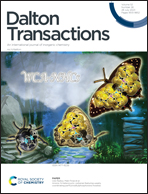Silver complexes with substituted terpyridines as promising anticancer metallodrugs and their crystal structure, photoluminescence, and DNA interactions†
Abstract
Six silver hexafluoroantimonate complexes (1–6) with 4′-(4′-substituted-phenyl)-2,2′:6′,2′′-terpyridine compounds bearing hydrogen (L1), methyl (L2), methylsulfonyl (L3), chloro (L4), bromo (L5) and iodo (L6) were prepared and characterized by 1H NMR, 13C NMR, IR, elemental analysis and single crystal X-ray diffraction. All the compounds exhibit interesting photoluminescence properties in the solid state and solution. In vitro data demonstrate that all of them show higher antiproliferative activities than cisplatin against three human carcinoma cell lines, A549, Eca-109 and MCF-7. Compound 3 exhibits the lowest IC50 value (2.298 μM) against A549 cell lines, which is 2.963 μM for 4 against Eca-109 and 1.830 μM for 1 against MCF-7. For silver halogen-substituted terpyridine compounds, their anticancer activities decrease following the sequence of –Cl, –Br, and –I substituents. The comparison results show that their anticancer activity is significantly higher than that of their free ligands. The DNA interaction was studied by fluorescence titration, circular dichroism spectroscopy and molecular modeling methods. Spectrophotometric results reveal that the compounds have strong affinity binding with DNA as intercalators and molecular docking studies indicate that the binding is contributed by the π–π stacking and hydrogen bonds. The DNA binding ability of the complexes has been correlated with their anticancer activities, which could potentially provide a new rationale for the future design of terpyridine-based metal complexes with antitumor potential.



 Please wait while we load your content...
Please wait while we load your content...